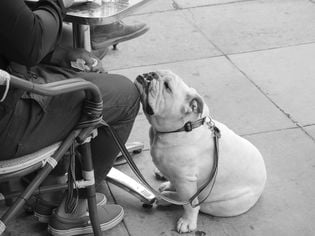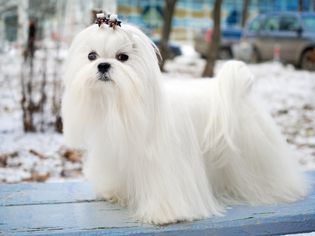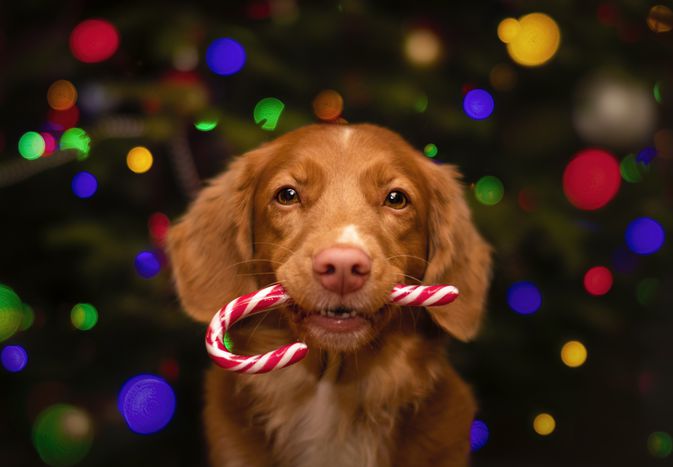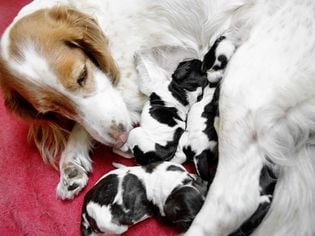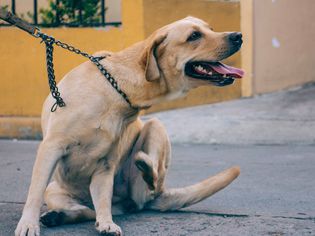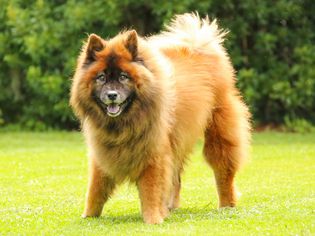The Alaskan husky is a medium-sized hybrid dog breed developed in the United States. The term ‘Alaskan husky’ is often loosely used to define any mixed-breed dog that has genetic traits of any northern breed dog like the Alaskan Malamute, Siberian husky, Inuit dog, or Greenland dog. Alaskan huskies are bred for characteristics ideal for being a sled dog: speed, intelligence, drive, athleticism, pulling aptitude, and endurance but are great pets for any active family.
Learn more about the care and characteristics of the Alaskan husky.
Breed Overview
Group: Hybrid
Height: 20 to 26 inches
Weight: 35 to 75 pounds
Coat: Short to medium, thick double-coat
Coat Color: Any color/pattern
Life Span: 14 to 16 years
Temperament: Friendly, intelligent, active
Hypoallergenic: No
Origin: United States
Characteristics of the Alaskan Husky
Since the Alaskan husky is a hybrid dog breed, their appearance and personalities can differ depending on which traits they inherit from their diverse parent breeds. Ultimately, they were developed with the sole intention of being extraordinarily skilled sled dogs.
Jaye Foucher, professional dog musher and breeder of Siberian huskies and Alaskan huskies at Sibersong Sleddogs says there are specific lines of Alaskan huskies, and their monikers refer to the type of sledding that they were bred for, including:
- Distance lines: These dogs were bred to have thicker double coats and traits suited for prime endurance and cold climates, Foucher explains. In markings and eyes, they often look very similar to Siberian huskies or Alaskan Malamutes and are genetically heavier on Arctic northern breeds.
- Sprint lines: Dogs with sprint lines are sleeker, more heat-tolerant, and bred for speed. They have more in common genetically with salukis, pointers, and hounds.
In her experience with distance lines, she considers the Alaskan husky’s temperament to be similar to the Siberian husky’s with the exception that they tend to be just a tad less affectionate.
“Most of my Siberians will get right in my face and lick me senseless, but my Alaskans are just not big kissers,” Foucher says. “Yet, they are still pack-oriented animals who prefer not to live alone and are very outgoing with humans—the same as Siberian huskies.”
She also describes Alaskan huskies as being more obedient, resilient, and high-energy compared to Siberians. While they're not big talkers, they do tend to bark more at strangers and love to do group howls.
| Affection Level | Medium |
| Friendliness | High |
| Kid-Friendly | Medium |
| Pet-Friendly | Medium |
| Exercise Needs | High |
| Playfulness | High |
| Energy | High |
| Trainability | Medium |
| Intelligence | High |
| Tendency to Bark | High |
| Amount of Shedding | High |
History of the Alaskan Husky
The Alaskan husky's exact origins are unknown, and the definition of what a "true" Alaskan husky depends on who you ask. Although, it's believed that this breed may have been initially developed around 12,000 years ago in what we now know to be Alaska.
Around this time, mushers (people who drive a dog sled) began breeding Siberian huskies with dog breeds who had ideal sled dog characteristics to create the ultimate sled dog. For example, they may have mixed with greyhounds for speed, Labrador retrievers for friendliness, and border collies for intelligence.
The Alaskan husky is not recognized by any breed registry, including the American Kennel Club (AKC). Even so, Foucher says most Alaskan husky breeders she knows keep breeding records and pedigrees and are very selective about breeding in the same way a responsible purebred breeder would be.
“As a result, genetic studies now can identify a specific DNA signature that is found in most Alaskan huskies that go back to the original Alaskan village dogs, which can be identified on DNA breed tests,” she says. “Those dogs are what I would consider a ‘true’ Alaskan husky.”
Alaskan Husky Care
Alaskan huskies are natural athletes who thrive when they're able to put their bodies and minds to work. Early socialization and positive reinforcement training is important for them to build good habits and set them up for success as they grow older.
Exercise
Alaskan huskies were quite literally bred to run and thus need plenty of exercise to fulfill their needs. This brawny breed requires anywhere from 1–3 hours minimum of aerobic exercise a day, Foucher says. She considers the best exercise to be a variation of a pulling sport, such as bikejoring, skijoring, or sledding. But they’re also ideal running and hiking companions, she adds.
Alaskan huskies need an outlet for their energy and are happiest in an environment where they can be active. Otherwise, they may very well partake in inappropriate, destructive behaviors out of boredom, Foucher says.
The duration of their outdoor exercise varies based on the weather. “In summer, they are inclined to be less active due to the heat, whereas a crisp 10-degree Fahrenheit day will have them climbing the walls,” she says.
As Alaskan huskies reach their golden years, Foucher says their energy levels will somewhat decrease. However, she knows many pet parents who adopt retired sled dogs who are eight or nine years old and hike avidly with their dogs. And a nine or 10-year-old Alaskan husky competing in The Iditarod, an annual 1,000 mile race held in Alaska, is not unheard of, she notes.
To keep an Alaskan husky mentally stimulated, Foucher recommends providing plenty of chew toys and opportunities for playtime with their doggie friends.
“During the summer months, I let mine run around for a few hours with a buddy or two in a pretty large play yard every day, and they all have Kongs or similar type toys to chew on the rest of the time,” she says. “Mine usually only have a 3–4 month maximum ’summer vacation’ between seasons; the rest of the time they are getting exercise running in a team either in front of a sled or a 4-wheeler.”
Grooming
While Alaskan huskies need lots of exercise, they don’t require ample grooming. Foucher says they’re very easy dogs to groom, though that’ll ultimately depend on how much northern breed is in their genes. But their fur naturally repels dirt when dry, they don’t need lots of bathing.
Thoroughly brush your Alaskan husky a few times a week and expect them to shed their undercoat once a year, usually in the summertime. This, Foucher says, is unlike her Siberian huskies who blow coat at least twice a year. Either way, you'll want to brush them more during times of increased shedding.
As with other breeds, it’s important to regularly trim your Alaskan husky's nails. (For reference, Foucher trims her Alaskan husky’s nails as needed 3–4 times a year, usually in the colder months.) Make sure to also brush their teeth daily, as well as check their ears weekly, cleaning them as needed.
Training
Alaskan huskies are intelligent, trainable dogs. However, they can be a bit willful, meaning consistency, patience, and frequent rewards are key. To help them establish good habits early on, Foucher says basic obedience training can—and should—be done from 8–12 weeks old. Pet parents of Alaskan huskies can start training them the minute they bring them home, Foucher says. This will help keep them mentally stimulated.
Alaskan huskies can also begin leash training around 12 weeks old. Foucher recommends starting with a quarter-of-a-mile to half-a-mile walk, gradually increasing the distance as they grow.
“Exposing them to as many different environments and experiences as possible in those initial six months of their lives is crucial,” she says. Early socialization is especially essential if you have children or other pets in the household.
If you’re looking to get your Alaskan husky involved in pull training or harness work, Foucher says she waits until her dogs reach at least eight months old to start them in harness training. Even then, she says the first few months are limited to short runs, so she makes sure to keep it as fun and positive as possible.
Common Health Problems
Generally, Alaskan huskies are healthy dogs who live to be 14–16 years old on average, Foucher says. But not unlike other dog breeds, they can be prone to certain genetic health issues. Some of these health problems include:
- Alaskan husky encephalopathy
- Glaucoma
- Epilepsy
According to the ASPCA, other conditions that affect Alaskan huskies include:
- Digestive issues
- Bladder issues
- Sensitive skin
- Hypothyroidism
- Diarrhea
Diet and Nutrition
Like all dog breeds, Alaskan huskies should eat a high-quality dog food that's nutritionally complete and balanced as well as appropriate for their life stage. How much they should be fed depends on the level of exercise they’re getting, as well as the brand of dog food being fed, Foucher says.
“Alaskan huskies have a very high metabolism and do tend to need more calories than other dogs in their size range to maintain rate,” she explains.
For her own dogs, Foucher feeds a kibble that’s specifically formulated for sled dogs and has a high fat and protein ratio and is 720 kcal per cup. She mixes this with raw meat for a 20/80 mix of raw meat to kibble in summer months and a 30/70 mix in colder months. “With those formulas, I’m feeding on average 1.5–2 cups of food per day to the females and 2–2.5 cups to the males in the summer, which is their least active time,” she says.
As her Alaskan huskies grow older, she adds a joint supplement into their diet. Foucher finds they rarely need anything else in their diet because their kibble is high-quality.
For specific recommendations on what or how much to feed your Alaskan husky, it's always best to consult your veterinarian.
Where to Adopt or Buy an Alaskan Husky
Foucher says finding an Alaskan husky in rescues or shelters might be possible where there are a lot of mushers around, such as the upper Midwest, northern New England, and Alaska, but it's not common. Check with your local animals shelters to see if there are any Alaskan huskies available for adoption near you.
For further information to help you find an Alaskan husky, check out the following rescue groups:
- Arctic Rescue
- Northern Lights Sled Dog Rescue
- Husky House
- Husky Rescue Alaska
- Shadow Husky Rescue
- The August Fund for Alaska Racing Dogs
If you'd like to purchase an Alaskan husky puppy, look for a responsible and ethical breeder who promotes the breed's health and well-being. Foucher says that since Alaskan huskies are bred for running, the cost actually increases the older they get, as they're considered more proven in harness.
"The bigger the musher name, the higher the price," Foucher notes.
She shares the following price ranges for Alaskan huskies:
- Alaskan husky puppy: $500 to $700
- Alaskan husky yearling: $800 to $1,000
- Experienced young and proven sled dog of 2+ years: $1,000+
Alaskan Husky Overview
Alaskan huskies are playful, friendly, and loyal dogs who can be a wonderful fit for active families. It's important they get lots of exercise and enrichment every day to be at their best.
Pros of the Alaskan Husky
- Friendly and devoted
- Fairly easy to groom
- Great companions for active families
Cons of the Alaskan Husky
- Require extensive daily exercise
- Need proper mental stimulation, or may engage in destructive behavior if bored
- Not ideal for apartment dwellers
More Dog Breeds and Further Research
If you’re interested in similar breeds that are similar to the Alaskan husky, check out these other breeds:
- Siberian husky
- Alaskan Malamute
- Samoyed
There’s a whole world of potential dog breeds out there—with a little research, you can find the right one to bring home!
- Is an Alaskan husky a good pet?
Yes! Alaskan huskies are active, working dogs who are friendly and fun. They can be a great fit for anyone who's prepared to provide them with lots of physical activity and mental stimulation.
What are Alaskan huskies a mix of?Alaskan huskies can be a mix of several types of breeds, such as Siberian huskies, Alaskan Malamutes, greyhounds, German shorthaired pointers, etc.
How much do Alaskan huskies cost?The cost of an Alaskan husky can vary depending on whether you adopt from a shelter or rescue or purchase one from a reputable breeder. Adoption costs may be a few hundred dollars. Purchasing an Alaskan husky can generally cost $500 to $1,000, sometimes more.

